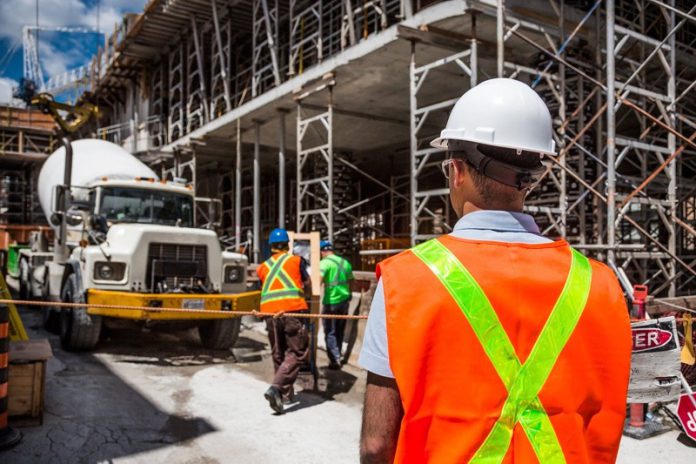A construction site can be a dangerous and intimidating place—especially if you don’t really know what you’re doing. And this negligence can lead to a worker being in the wrong place at the wrong time, which is why contact with equipment is the third leading cause of death on a construction site. But everyone must start somewhere, and with that in mind, we’ve compiled the following simple three-step guide to construction basics.
Construction site basics include observing proper worksite etiquette, familiarizing yourself with the right equipment, and knowing what to expect from a well-run project. Knowing this foundational information isn’t only important for one’s potential career advancement, but for personal safety as well.
Of course, there is a lot more to know before one can feel comfortable putting on a hard hat and showing up to work in construction. So be sure to read on for more details on important aspects of construction site basics below.
Step 1: Construction Site Etiquette
The number of rules you are expected to follow on a construction site can be head spinning. But this is because they are designed to keep everyone safe as they work. And this includes not just laborers, but the safety of the general public as well.
The following construction etiquettes should always be followed:
- Be vocal: Communication is key on a job site, but to minimize the risk of communication it is always advisable to use clear, unambiguous language when giving or receiving direction on-site.
- Be curious: Ask questions before you arrive at the job site. These can be as simple as who will you be working with and what tools will you need?
- Don’t assume you’re visible: Always be careful to stay well clear of heavy machinery, especially when it is in use, as the operator does not always have clear sightlines. This means they may not see someone until it is too late—and a hi-vis vest will do little to protect someone who has been smacked by a crane.
- Stay alert: Similar to the above tip, always be aware of your surroundings and what you are doing.
- Secure everything: This includes yourself, your tools, refuse, and anything else you may come into contact with on a jobsite. This may seem like overkill, but a falling shingle (or worse, hammer) can cause great damage to any unlucky soul below it.
- Be on time: Check in with your project manager when arriving and before leaving. Don’t be late. Always show up for work sober, failure to do so often results in instant termination.
Step 2: Construction Equipment to Familiarize Yourself With
Besides some basic tools and safety gear, what equipment is required will vary depending on what sort of project is being worked on. Roofers will need nail guns and tar while plumbers will need wrenches and pipe dope. Below are just a few pieces of equipment that workers should familiarize themselves with.
Construction Equipment Everyone Should Know
- PPE (Hardhat, goggles, earplugs, steel-toed boots, gloves)
- Toolbelt
- Durable and versatile work clothes (coveralls made of non-synthetic fibers are a good choice)
- Hand tools (Hammer, screwdriver, level, prybar)
- Heavy equipment (Cherry pickers, levelers, bulldozers, compactors, tractors, etc.)
- Two-way radio
- Dumpsters
- Self dumping hoppers
- Transportation (construction workers often must rely on personal vehicles due to the odd hours they work)
Step 3: On-site on the Job
With the basics of safety and equipment taken care of, it’s finally time to get to work. A well-organized project will have several disparate steps that will be taken to ensure everything proceeds smoothly.
- Planning and permitting: This portion of the construction process normally involves providing the proper plans to local officials for approval and relies on experts such as civil engineers, architects, and project managers.
- Sitework: Once a plan is approved and permits have been issued, it is time to get the site ready for construction. This can include leveling the surface, trenching, removing unwanted landscaping, and even irrigation work. All of this is combined under the sitework, or pre-construction, phase.
- Foundation construction: With the site adequately prepared, it is time for the foundation of the building to be laid. This is typically done by a subcontractor due to the specialized equipment and skills that are required.
- Structure construction: With a solid foundation laid, the superstructure can now begin to be built. The superstructure refers to anything built upwards from what has been designated ground level. This phase involves a lot of moving parts and proper organization of labor is a must to ensure loads are safely and evenly distributed.
- Punch lists: The final step includes lists of tasks such as electrical, plumbing, and other vital systems work that must be completed before final code inspections. (See what a code inspection in S.C. looks like here.
Construction is Always Changing
Construction is a faced paced industry with new initiatives and advancements being made all the time. Therefore, it always pays to stay on top of best practices to remain at your professional peak.
We hope you enjoyed reading about construction site basics and that you’ve learned something new along the way. As always, thank you for reading!















